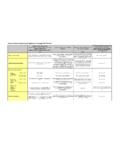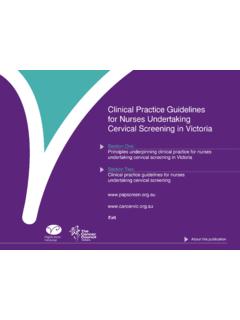Transcription of Guidance for Measuring Breast, Cervical, and Colorectal ...
1 March 2018 Measuring Breast, cervical , and Colorectal cancer Screening Rates in Health System Clinics CDC RFA DP15-1502 Organized Approaches to Increase Colorectal cancer Screening CDC RFA DP17-1701 National Breast and cervical cancer Early Detection Program i Contents Purpose .. 1 Reporting Requirements .. 2 Selecting a cancer Screening Rate Measure and Using It 3 Selecting a cancer Screening Rate Measure .. 3 Baseline Time Period .. 4 Reporting an Annual Screening Rate .. 4 Measuring Consistently .. 4 Calculating NQF-Endorsed Breast cancer Screening Rate 4 Step 1. Determining the Measurement Year .. 5 Step 2. The NQF-Endorsed Breast cancer Screening Rate Measure Definition .. 5 Step 3. Defining the Denominator .. 5 Step 4. Defining the Numerator .. 5 Calculating NQF-Endorsed cervical cancer Screening Rate Measure.
2 5 Step 1. Determining the Measurement Year .. 6 Step 2. The NQF-Endorsed cervical cancer Screening Rate Measure Definition .. 6 Step 3. Defining the Denominator .. 6 Step 4. Defining the Numerator .. 6 Calculating NQF-Endorsed Colorectal cancer (CRC) Screening Rate Measure .. 6 Step 1. Determining the Measurement Year .. 7 Step 2. The NQF-Endorsed CRC Screening Rate Measure Definition .. 7 Step 3. Defining the Denominator .. 7 Step 4. Defining the Numerator .. 7 Measurement Considerations for FOBT/FIT .. 7 Measurement Considerations for Electronic Health Records (EHRs) .. 8 Validating the EHR Rate .. 9 Using Medical Chart Review to Estimate cancer Screening Rate .. 10 Proportion of Medical Charts to 10 Selecting Appropriate Charts .. 10 ii Determine the Sampling Frame.
3 10 Sampling Method .. 11 Measurement Year .. 11 Additional 12 Assessing Data Reliability .. 12 Tools and Resources .. 13 Information Sources .. 14 Appendices: Screening Measure Tables 1 Purpose The purpose of this document is to provide Guidance to grantees of CDC s National Breast and cervical cancer Early Detection Program ( NBCCEDP) and Colorectal cancer Control Program (CRCCP) for Measuring baseline and, thereafter, annual cancer screening rates within participating health system clinics. Given the emphasis on partnering with health systems to implement evidence-based strategies, this Guidance is centered in that context. Organizations outside of the NBCCEDP and CRCCP may also find this Guidance useful for effectively monitoring screening rates. 2 Reporting Requirements An important purpose of the NBCCEDP and CRCCP is to increase breast, cervical , and Colorectal cancer screening rates (a priority outcome) within partner health system clinics that serve priority population(s).
4 NBCCEDP and CRCCP grantees are required to implement evidence-based interventions (EBIs) in partnership with health system clinics to increase screening rates. In addition, grantees are required to report baseline and annual data for every participating clinic to CDC. These data include a clinic-level screening rate. Health system partners may include Federally Qualified Health Centers (FQHCs), Community Health Centers (CHCs), health care/hospital networks, Indian Health Service (IHS), local health department clinics, and others. Health systems often have multiple clinics (also referred to as sites among FQHCs). As grantees may intervene with only a single or subset of these clinics and may implement different activities in different clinics, a baseline cancer screening rate is expected to be measured and reported for every clinic within a health system, rather than for the overall health system, where NBCCEDP or CRCCP activities will be implemented.
5 After baseline data have been reported, report an updated cancer screening rate annually thereafter. These data will allow grantees and CDC to monitor changes in cancer screening rates in all clinics where EBIs are implemented and allow us to demonstrate the impact of the NBCCEDP and CRCCP. 3 Selecting a cancer Screening Rate Measure and Using It Consistently This section describes the importance of selecting a specific measure or method to calculate the screening rate at baseline, and then using that same measure or method consistently throughout the grant reporting period. The section offers two options for reporting cancer screening rates: 1. Using an existing measure, such as the Health Resources and Services Administration s (HRSA s) Uniform Data System (UDS).
6 2. Calculating a new rate based on the National Quality Forum (NQF)-endorsed measure. As part of initial assessment efforts conducted with a partner health system, identify the option that is most appropriate for each clinic where program activities are planned. Selecting a cancer Screening Rate Measure Several measures exist to monitor breast, cervical , and Colorectal cancer screening rates within a health system or clinic. Appendix 1 provides a comprehensive overview of these measures. If there are collaborations with a health system clinic that already reports one of these measures, such as UDS or the Healthcare Effectiveness Database and Information System ( HEDIS), this measure may be reported to CDC. This may help to facilitate partnership development and build on the existing health system/clinic structure.
7 However, work closely with partner health systems or clinics to improve the quality of their reporting, particularly if there is evidence of imprecision or inconsistency in breast, cervical , and/or Colorectal cancer screening rate reporting (see section below titled Electronic Health Record, or EHR, validation). Also, be aware that HRSA requires FQHCs to submit a screening rate for the health system as a whole; CDC requires screening rates for the clinic/site. When using an existing cancer screening rate measure such as UDS for a given clinic, report the measure for the same 12-month time period as was reported to the external system ( for example, for UDS, reporting is to HRSA for the calendar year, January through December) and follow the same guidelines recommended for calculating that measure (see Appendix 1).
8 For example, let s say there is a partnership with a FQHC health system that has six clinic sites and program activities are implemented in four of them. In this example, report the UDS screening rates for the time period January through December for each of the four clinics to CDC. Even if the FQHC reported a single, aggregate screening rate for the entire health system to HRSA, provide the clinic-level rate for each of the four clinics to CDC. Again, report to CDC the values representing the same 12-month measurement year that was used to report to HRSA. Do not report a number that has been updated to represent a different and/or longer measurement year. Important Note: In CDC s data collection, grantees report both the numerator and denominator population sizes (raw data) for calculating the screening rate at baseline and annually.
9 4 Baseline Time Period Grantees need to determine a baseline screening rate for each participating clinic prior to implementing NBCCEDP or CRCCP program activities (EBIs). Specifically, the baseline measurement year represents the most recent 12-month measurement year that precedes intervention activities. For instance, program activities in a given FQHC clinic that began in November 2017 would report a baseline screening rate (such as UDS) for the time period January through December 2016. Reporting an Annual Screening Rate After a baseline screening rate is reported for a given clinic, provide annual data to CDC for that clinic, including an annual screening rate, every year through the end of the five-year program period, regardless of whether your program implements activities for that entire period1.
10 For instance, a clinic is identified in program year (PY) 1, and, based on assessment activities, patient and provider reminder systems are implemented over a three-year period. In this scenario, a baseline screening rate for the clinic during PY1 would be reported prior to implementing activities followed by annual data, including an annual screening rate, for PY2 through PY5. This allows grantees and CDC to track screening rates over time and assess the full impact of the EBIs that were implemented. Note: CDC requires grantees to report screening rates annually. However, these rates may be monitored more frequently (monthly or quarterly) and provide feedback to clinics on their progress. Measuring Consistently Grantees may use different screening measures for different clinics ( such as HEDIS for Clinic 1 and UDS for Clinic 2).













